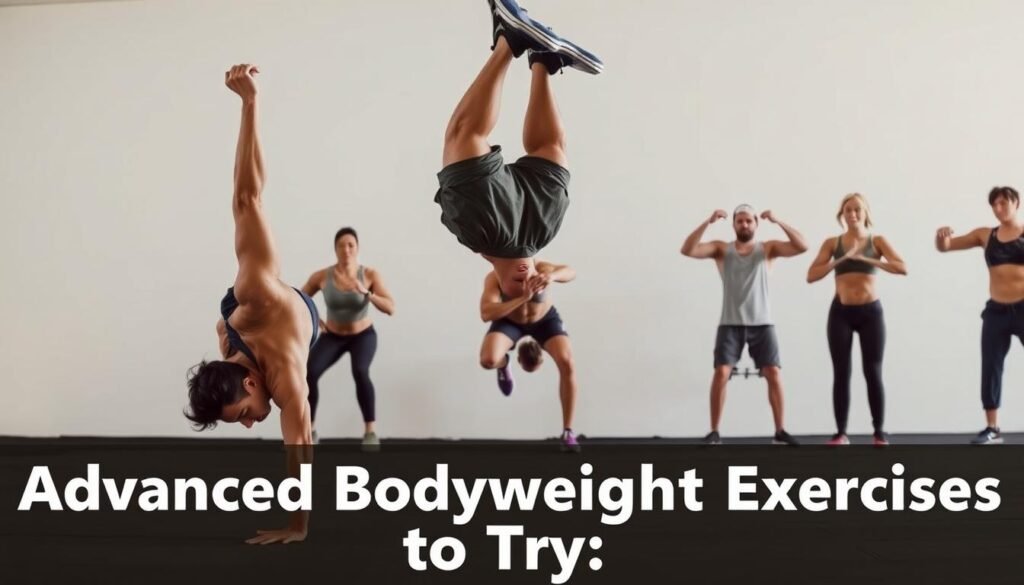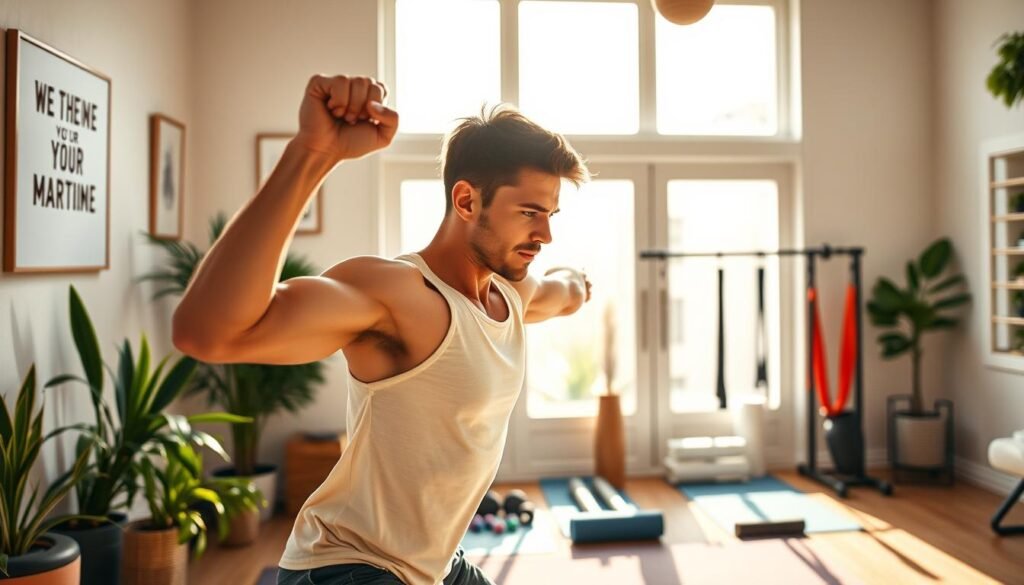Looking for a way to stay fit and boost your immunity without equipment? You can reach your fitness goals with simple bodyweight exercises at home. A regular home exercise routine can boost your health and well-being.
Adding bodyweight workouts to your daily routine can improve your fitness and immune system. Exercise keeps you energized and focused all day.
Key Takeaways
- Bodyweight exercises can be done at home without any equipment.
- A consistent exercise routine can improve overall health and fitness.
- Regular physical activity can help boost your immune system.
- Home workouts offer flexibility and convenience.
- Simple exercises can be effective in enhancing physical fitness.
What Are Bodyweight Workouts?
Bodyweight workouts are a great way to stay fit at home without any equipment. They use your own body weight to build strength and improve flexibility. This makes you more fit overall.
These exercises are easy to do anywhere. They’re perfect for those who like to work out at home or have a busy schedule.
Definition and Benefits
Bodyweight workouts use your body as resistance. You can do squats, push-ups, and planks. They help increase strength, improve flexibility, and boost heart health.
The key benefits of bodyweight workouts are:
- Increased strength and muscle tone
- Improved flexibility and mobility
- Enhanced cardiovascular health
- Better balance and coordination
- No need for any equipment or gym membership
| Exercise | Primary Benefit | Secondary Benefit |
|---|---|---|
| Squats | Leg Strength | Improved Balance |
| Push-Ups | Upper Body Strength | Core Engagement |
| Planks | Core Strength | Improved Posture |
How They Improve Functional Fitness
Bodyweight workouts boost your ability to do daily tasks well. Functional fitness means you can do tasks that need coordination, balance, and strength.
Adding bodyweight exercises to your routine makes daily activities easier. It also lowers the chance of getting hurt.
The Role of Exercise in Immunity
Regular physical activity can greatly boost your immune system. It’s not just about staying fit; it’s also key to a strong immune system. Knowing how exercise affects your immune health helps you make better choices for your well-being.
How Physical Activity Strengthens Your Immune System
Studies show that exercise boosts your immune response. Regular exercise increases white blood cell production, which fights infections. It also lowers inflammation, a major cause of chronic diseases.
Exercise affects your immune system in many ways. It improves the flow of antibodies and white blood cells. This makes your body better at fighting off germs.
Impact of Stress Reduction on Immunity
Exercise is a great stress reliever, and reducing stress is key for a healthy immune system. Stress raises cortisol levels, which weakens the immune system. Exercise helps lower stress, keeping your immune system strong.
Exercise also improves sleep, which boosts immune function. Better sleep means a more effective immune system.
| Exercise | Immunity Benefit | Frequency |
|---|---|---|
| Brisk Walking | Improves circulation, boosts white blood cells | 30 minutes, 5 times a week |
| Swimming | Reduces stress, improves overall health | 20 minutes, 3 times a week |
| Cycling | Enhances cardiovascular health, reduces inflammation | 30 minutes, 4 times a week |
Setting Up Your Home Workout Space
Creating a good home workout space is key for sticking to your at-home fitness plan.
You need to think about a few things: where to put your workout area and what makes it comfy and safe.
Choosing the Right Location
When picking a spot for your workout, look at the space you have and how private it is.
It’s best to find a place with no distractions, so you can focus on your home exercise routine.
Any corner of your living room, a spare bedroom, or even a garage can work well if it fits your needs.
Essential Elements for Comfort and Safety
To make your workout space comfy and safe, consider a few things.
- A non-slippery floor or a good quality exercise mat to prevent injuries during no-gym workouts.
- Good ventilation and lighting to make the space comfortable.
- Keep it distraction-free, like turning off phone notifications or placing it away from busy areas.
- Have water and a towel nearby to stay hydrated and comfy during your workout.
By paying attention to these details, you can set up a home workout space that helps you reach your fitness goals and makes your workouts better.
Essential Bodyweight Exercises for Beginners
Starting to work out at home? Knowing the basic bodyweight exercises is key. They help build strength and boost your immune system.
Squats
Squats are a basic exercise that works many muscles. Stand with your feet apart, then lower down until your thighs are almost touching the ground. Push through your heels to stand up again.
For safe squats, keep your back straight and lower down slowly. Beginners, start with bodyweight squats and add more challenges later.
Push-Ups
Push-ups target your upper body, like your chest, shoulders, and triceps. Start in a plank position, lower down until your chest almost touches the ground, then push back up.
Beginners, keep your body straight from head to heels. If push-ups are hard, try modified ones on your knees.
Planks
Planks strengthen your core, which is key for balance and stability. Hold a plank position like a push-up, with your body straight.
Engage your core by pulling your belly button towards your spine. Hold for as long as you can, starting with short intervals and increasing as you get stronger.
| Exercise | Primary Muscles Worked | Tips for Beginners |
|---|---|---|
| Squats | Legs, Glutes, Core | Keep your back straight and push through your heels. |
| Push-Ups | Chest, Shoulders, Triceps | Start with modified push-ups if needed, and maintain a straight body line. |
| Planks | Core | Engage your core and hold the position steadily. |
Creating a Balanced Home Exercise Routine
Creating a home workout routine that’s varied and challenging is key to staying fit and boosting your immune system. A balanced routine keeps you engaged and works on different fitness areas.
A balanced routine isn’t just about repeating the same exercises. It’s about mixing exercises that challenge your body in different ways.
Importance of Variety in Workouts
Variety in workouts is crucial to avoid plateaus and prevent injuries. Mixing different exercises ensures you’re working on strength, flexibility, and cardiovascular health. This makes your workouts interesting and keeps them challenging.
For example, if you’re doing bodyweight exercises, try changing the intensity, reps, or sets. You can also add exercises that target the same muscles but differently.
Combining Strength and Cardio
Combining strength training with cardio is essential for a balanced routine. Strength training builds muscle and boosts metabolism. Cardio exercises improve heart health and burn calories.
Alternating between strength training and cardio days is a simple way to combine them. For example, do squats, push-ups, and planks on Monday, Wednesday, and Friday. Then, dedicate Tuesday and Thursday to cardio like jumping jacks or burpees.
| Day | Exercise Type | Example Exercises |
|---|---|---|
| Monday | Strength Training | Squats, Push-Ups, Planks |
| Tuesday | Cardio | Jumping Jacks, Burpees |
| Wednesday | Strength Training | Lunges, Dips, Glute Bridges |
| Thursday | Cardio | Running in Place, Mountain Climbers |
Advanced Bodyweight Exercises to Try
Once you’ve learned the basics of bodyweight workouts, it’s time to try harder exercises. These exercises will test your strength and endurance. They also boost your fitness and help keep your immune system strong.
Advanced bodyweight exercises need more strength, flexibility, and coordination. They are made for those who are already quite fit. They help you keep improving in your fitness journey.
Burpees
Burpees are a full-body exercise that combines a squat, push-up, and jump. They are a great no-equipment workout. Start by standing, then drop into a squat, kick back into a plank, do a push-up, and quickly return to standing before jumping up.

Burpees are very intense. They can be adjusted for different fitness levels. Beginners can start by stepping back into a plank instead of jumping.
Single-Leg Deadlifts
Single-leg deadlifts are a tough exercise that need balance, strength, and flexibility. They work your legs, glutes, and back. They are a great addition to any bodyweight workout routine.
To do a single-leg deadlift, stand on one leg, bend forward at the hips, and lower your torso until it’s parallel to the ground. Keep your other leg straight and lift it behind you, forming a straight line from head to heel.
Handstand Push-Ups
Handstand push-ups are an advanced exercise that targets your shoulders, triceps, and upper back. They require a lot of strength and control. They are perfect for those who want to level up their outdoor bodyweight exercises.
To do a handstand push-up, start by kicking up into a handstand against a wall. Lower your body by bending your elbows until your head is almost touching the ground, then push back up to the starting position.
Crafting Your Weekly Schedule
To get the most out of no-gym workouts, plan a weekly routine that fits your life. A good schedule keeps you consistent and helps you reach your fitness goals.
Designing a Flexible Routine
A flexible routine is key for sticking to your home workouts long-term. It lets you adjust your exercises to fit your day and energy. Here are some tips for your routine:
- Begin with a few workout days a week.
- Include both strength training and cardio.
- Make sure to include rest days for recovery.
Fitness experts say, “Being consistent is important, but so is resting. Having a balance between working out and resting is crucial for progress and avoiding burnout.”
“The key to a successful fitness journey is not just about the intensity or frequency of workouts, but also about recovery and consistency.” –
Tips for Staying Consistent
Keeping up with your home workouts can be tough, but it’s doable with the right mindset. Here are some tips:
- Set achievable goals and track your progress.
- Work out with a friend or join online fitness groups for motivation.
- Change up your routine to avoid getting stuck in a rut.
| Day | Workout Type | Focus Area |
|---|---|---|
| Monday | Strength Training | Upper Body |
| Tuesday | Cardio | Endurance |
| Wednesday | Rest | Recovery |
| Thursday | Strength Training | Lower Body |
| Friday | Cardio | High Intensity |
By following these tips, you can make a weekly plan that fits your life and helps you reach your fitness goals through no-gym workouts.
Incorporating Flexibility and Mobility Work
To get the best fitness and immunity, add flexibility and mobility exercises to your home workouts. These exercises boost your performance, help with recovery, and improve your overall health.
Essential Stretches for Recovery
After doing your immunity boosting exercises, it’s key to stretch. Focus on big muscle groups like hamstrings, quadriceps, and hip flexors. For example, stretch your hamstrings by standing with your feet apart and leaning forward to touch your toes.
Stretching regularly can lessen muscle soreness and boost your movement. Stretch when your muscles are warm after working out.
| Muscle Group | Stretching Exercise | Duration |
|---|---|---|
| Hamstrings | Standing Forward Bend | 30 seconds |
| Quadriceps | Standing Quad Stretch | 30 seconds per leg |
| Hip Flexors | Kneeling Hip Flexor Stretch | 30 seconds per leg |
Benefits of Yoga and Pilates
Yoga and Pilates are great for improving flexibility, balance, and core strength. They add to your at-home fitness and help your mental health by lowering stress and boosting mindfulness.
Yoga offers a complete fitness approach with styles like Hatha, Vinyasa, and Restorative. Pilates focuses on core strength, body control, and precise movements. Both can be done at home with little equipment and suit all fitness levels.
Adding these practices to your routine can make you more flexible, improve your posture, and enhance your overall health. Start with online classes or videos that match your fitness level.
Staying Motivated During Home Workouts
Keeping up motivation for at-home workouts can be tough. Without a gym, it’s easy to lose focus. But, with the right strategies, you can keep going and reach your fitness goals.
Setting Realistic Goals
Setting goals that you can really reach is key. Clear, achievable goals help you see your progress and stay motivated.
- Start with small, manageable goals that you can build upon.
- Be specific about what you want to achieve, whether it’s exercising for a certain amount of time or completing a specific number of workouts per week.
- Make sure your goals are measurable and achievable within a realistic timeframe.
Social Support and Accountability
A support system can really boost your motivation. This can be friends, family, or online groups.
- Find a workout buddy or accountability partner who shares your fitness goals.
- Join online forums or social media groups dedicated to bodyweight workouts and at-home fitness.
- Share your progress and achievements with friends and family to gain their support and encouragement.

By setting realistic goals and getting support, you can stay motivated. Stay committed, and you’ll see progress over time.
Nutrition Tips to Complement Your Workouts
As you keep up with your bodyweight workouts, it’s key to eat the right foods. This helps boost your immunity and supports your fitness goals. A good diet works hand in hand with your workouts, helping your body recover and perform better.
Foods That Boost Immunity
Adding certain foods to your diet can really help your immune system. Foods packed with antioxidants, like berries and leafy greens, fight oxidative stress. This stress can weaken your immune system.
Also, foods with vitamin C, such as citrus fruits and bell peppers, are great for your immunity. Fermented foods like yogurt and kimchi support gut health. A healthy gut is essential for a strong immune system.
| Food | Nutrient | Benefit |
|---|---|---|
| Berries | Antioxidants | Reduces oxidative stress |
| Citrus Fruits | Vitamin C | Boosts immune response |
| Leafy Greens | Antioxidants, Vitamins | Enhances overall health |
Importance of Hydration
Drinking enough water is just as important as eating right. Water helps make lymph, which carries immune cells around your body.
Try to drink at least eight glasses of water a day. Adjust this based on how active you are and where you live. Eating hydrating foods like watermelon and cucumbers can also help.
By eating a balanced diet full of immune-boosting foods and staying hydrated, you can improve your immune system. This will also help you perform better in your workouts.
Tracking Your Progress
To see how your no-equipment workouts are working, tracking your progress is key. It keeps you motivated and helps you tweak your routine as needed.
Using Apps and Wearables
Technology is a big help in your fitness journey. Apps and wearables make it easy to track your workouts, heart rate, and what you eat. Apps like MyFitnessPal and Nike Training Club have tools to help you manage your workouts and diet.
When picking an app or wearable, think about what you need most. Some focus on certain exercises, while others offer more features.
| Feature | Apps | Wearables |
|---|---|---|
| Workout Tracking | Yes | Yes |
| Heart Rate Monitoring | Limited | Yes |
| Nutritional Logging | Yes | Limited |
Keeping a Workout Journal
Keeping a workout journal is another great way to track your progress. Write down your exercises, how many sets and reps, and how you feel afterward. It helps you see how far you’ve come and what you need to work on.
Whether digital or physical, a workout journal is a personal tool. It can be as simple as a notebook or as detailed as a spreadsheet, based on what you like.
Using both tech and traditional methods is a strong way to track your progress. Choose what works best for you, whether it’s apps and wearables or a workout journal. The most important thing is to find a method that you enjoy and stick with it.
Success Stories: Real People, Real Results
Bodyweight workouts can lead to big fitness gains and a stronger immune system. Many people have seen amazing changes by working out at home and outdoors.
Transformations Through Bodyweight Workouts
Sarah, a fitness lover, has greatly improved her health with bodyweight exercises. Doing squats, push-ups, and planks can make you stronger and boost your immune system.
Testimonials and Inspirational Journeys
People who use bodyweight workouts share their success stories. Their experiences can motivate you to start your own fitness journey at home. You can also enjoy the outdoors while exercising.
Following the paths of those who have succeeded can help you reach your fitness goals. You’ll enjoy a healthier, more active life through bodyweight workouts.



